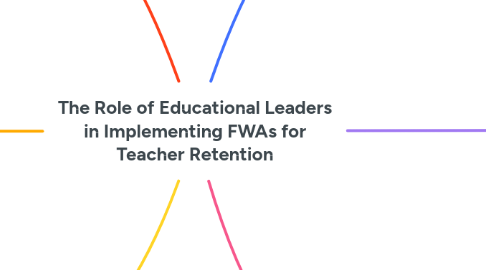
1. Context & Problem Statement
1.1. Increasing teacher attrition in Nigeria
1.2. COVID-19 exacerbated working conditions
1.3. Poor salaries, lack of motivation, rigid work conditions
1.4. UNESCO: Severe shortages by 2030 in sub-Saharan Africa
2. Flexible Work Arrangements (FWAs)
2.1. Evaluation Gaps
2.1.1. Lack of Nigerian-based FWA research
2.1.2. Small-scale studies (e.g., Byden, 2023)
2.2. Definition & Global Context
2.2.1. Types: part-time, job-sharing, remote work, compressed hours
2.2.2. Adopted in UK, Finland, Australia
2.2.3. Accelerated during COVID-19
2.3. Benefits
2.3.1. Improved well-being & reduced stress (Riskarini et al., 2024)
2.3.2. Better retention & performance (Obisi, 2017; Ridwan et al., 2022)
2.4. Barriers
2.4.1. Scheduling conflicts & staff shortages (CooperGibson, 2020)
2.4.2. Perceived financial strain (IFF Research, 2023)
3. Educational Leadership
3.1. Strategic Role in FWAs
3.1.1. Creating policy & support structures (Shrestha, 2022)
3.1.2. Managing workload, wellbeing, logistics (DfE, 2017)
3.2. Transformational Leadership
3.2.1. Personalised support, vision, innovation (Breevaart & Bakker, 2018)
3.2.2. Encouraging autonomy & motivation
3.3. Teacher Motivation & Support
3.3.1. Intrinsic vs extrinsic factors (Omotoyinbo & Olaniyi, 2019)
3.3.2. Leadership presence improves retention (Lochmiller et al., 2024)
3.4. Impact
3.4.1. Builds a sense of purpose
3.4.2. Direct influence on FWA effectiveness
4. Research Gaps & Future Direction
4.1. Need for large-scale Nigerian studies on FWAs
4.2. Explore cost-benefit analyses in Nigerian contexts
4.3. Investigate gender dynamics in FWA preferences
4.4. Expand leadership-focused research in rural schools
5. Policy Implications
5.1. FWAs must move from optional to necessary
5.2. Requires institutional commitment and leadership buy-in
5.3. Training for school heads on implementing FWAs
5.4. Alignment with national teacher development frameworks
6. Research Sources & Critique
6.1. Primary Sources
6.1.1. Academic journals, empirical studies
6.1.2. Mixed-method and case studies (e.g., Ackah-Jnr et al., 2022; Dousin et al., 2020)
6.1.3. Limitations: sampling issues, generalisability
6.2. Secondary Sources
6.2.1. Policy documents (DfE, Education Support)
6.2.2. Reports (UNESCO, CooperGibson)
6.2.3. Value: strategic guidance & broader context
